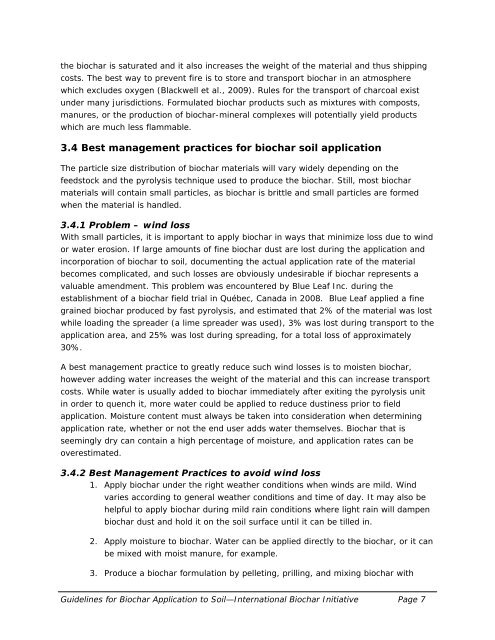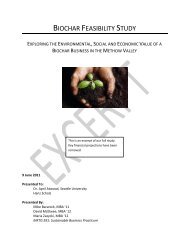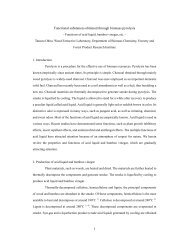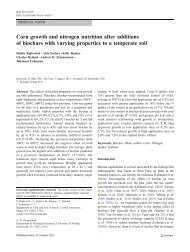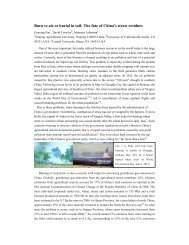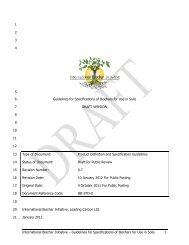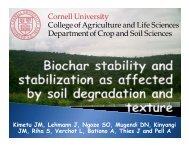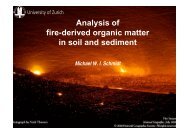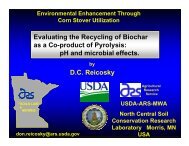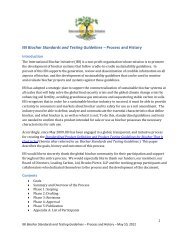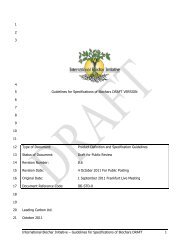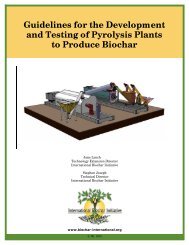Guidelines on Practical Aspects of Biochar Application to Field Soil ...
Guidelines on Practical Aspects of Biochar Application to Field Soil ...
Guidelines on Practical Aspects of Biochar Application to Field Soil ...
- No tags were found...
Create successful ePaper yourself
Turn your PDF publications into a flip-book with our unique Google optimized e-Paper software.
the biochar is saturated and it also increases the weight <strong>of</strong> the material and thus shippingcosts. The best way <strong>to</strong> prevent fire is <strong>to</strong> s<strong>to</strong>re and transport biochar in an atmospherewhich excludes oxygen (Blackwell et al., 2009). Rules for the transport <strong>of</strong> charcoal existunder many jurisdicti<strong>on</strong>s. Formulated biochar products such as mixtures with composts,manures, or the producti<strong>on</strong> <strong>of</strong> biochar-mineral complexes will potentially yield productswhich are much less flammable.3.4 Best management practices for biochar soil applicati<strong>on</strong>The particle size distributi<strong>on</strong> <strong>of</strong> biochar materials will vary widely depending <strong>on</strong> thefeeds<strong>to</strong>ck and the pyrolysis technique used <strong>to</strong> produce the biochar. Still, most biocharmaterials will c<strong>on</strong>tain small particles, as biochar is brittle and small particles are formedwhen the material is handled.3.4.1 Problem – wind lossWith small particles, it is important <strong>to</strong> apply biochar in ways that minimize loss due <strong>to</strong> windor water erosi<strong>on</strong>. If large amounts <strong>of</strong> fine biochar dust are lost during the applicati<strong>on</strong> andincorporati<strong>on</strong> <strong>of</strong> biochar <strong>to</strong> soil, documenting the actual applicati<strong>on</strong> rate <strong>of</strong> the materialbecomes complicated, and such losses are obviously undesirable if biochar represents avaluable amendment. This problem was encountered by Blue Leaf Inc. during theestablishment <strong>of</strong> a biochar field trial in Québec, Canada in 2008. Blue Leaf applied a finegrained biochar produced by fast pyrolysis, and estimated that 2% <strong>of</strong> the material was lostwhile loading the spreader (a lime spreader was used), 3% was lost during transport <strong>to</strong> theapplicati<strong>on</strong> area, and 25% was lost during spreading, for a <strong>to</strong>tal loss <strong>of</strong> approximately30%.A best management practice <strong>to</strong> greatly reduce such wind losses is <strong>to</strong> moisten biochar,however adding water increases the weight <strong>of</strong> the material and this can increase transportcosts. While water is usually added <strong>to</strong> biochar immediately after exiting the pyrolysis unitin order <strong>to</strong> quench it, more water could be applied <strong>to</strong> reduce dustiness prior <strong>to</strong> fieldapplicati<strong>on</strong>. Moisture c<strong>on</strong>tent must always be taken in<strong>to</strong> c<strong>on</strong>siderati<strong>on</strong> when determiningapplicati<strong>on</strong> rate, whether or not the end user adds water themselves. <strong>Biochar</strong> that isseemingly dry can c<strong>on</strong>tain a high percentage <strong>of</strong> moisture, and applicati<strong>on</strong> rates can beoverestimated.3.4.2 Best Management Practices <strong>to</strong> avoid wind loss1. Apply biochar under the right weather c<strong>on</strong>diti<strong>on</strong>s when winds are mild. Windvaries according <strong>to</strong> general weather c<strong>on</strong>diti<strong>on</strong>s and time <strong>of</strong> day. It may also behelpful <strong>to</strong> apply biochar during mild rain c<strong>on</strong>diti<strong>on</strong>s where light rain will dampenbiochar dust and hold it <strong>on</strong> the soil surface until it can be tilled in.2. Apply moisture <strong>to</strong> biochar. Water can be applied directly <strong>to</strong> the biochar, or it canbe mixed with moist manure, for example.3. Produce a biochar formulati<strong>on</strong> by pelleting, prilling, and mixing biochar with<str<strong>on</strong>g>Guidelines</str<strong>on</strong>g> for <strong>Biochar</strong> Applicati<strong>on</strong> <strong>to</strong> <strong>Soil</strong>—Internati<strong>on</strong>al <strong>Biochar</strong> Initiative Page 7


